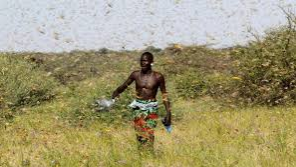Desert Swarms: A New 2020 Outbreak ?

https://www.nationalgeographic.com/science/2020/02/locust-plague-climate-science-east-africa/
One of the most famous pictures taken so far in Kenya, the visualization of the locust filled skies that cover miles and miles of farmland.
March 17, 2020
Trouble has arisen south of the equator as swarms of skin-crawling locusts cover the farm lands of Somalia, Kenya and Ethiopia. As the worst locust outbreak in decades, this poses a threat to the livelihood of those in the region, potentially on several levels.
Desert locusts are among the most ruinous of the locust species — known for their rapid growth and huge appetites — these swarms, each containing around 2 billion locusts, are pressing the people and farms of the region, with this infestation.
Keith Cressman, a locust forecasting officer who recently returned from Kenya and Somalia, told Business Insider that the locusts resemble: “A moving carpet of yellow and black objects” stating that they move in unison, packed so closely that the ground below them isn’t even visible. The very present theory that they will continue to migrate and cover more regions in Africa is looking very real recently as the reproductive rates of these locusts keep on rising.
Ms. Tiffany Malagari, a history teacher at Oakdale, made comments about several theories for the treatment of this plague, some sound strange but others may be effective: “They are multiplying faster than they can be contained and the only treatment option available is pesticides or ducks.”
She clarified, “The duck idea was suggested as a more natural method of containing the swarms instead of chemicals, but not all affected areas have the right environment to support ducks.”
These locusts are no joke, each of these insects consumes their body weight in food daily. According to a UN briefing, this is the equivalent to the food that 84 million people are able to eat in a day. Further, these swarms can spread over 460 square miles, with an average calculation of 40 million to 80 million locusts per half-square mile.
The vast majority of the land covered is farmland, producing the bulk of the region’s food supply. While they threaten the food supply of tens of millions of people, as city-sized swarms devastate the people living in their midst, many wonder what is to blame for this phenomenon.
Experts claim that the unusually long string of wet and warm weather, more than likely due to the several rare cyclones that struck Eastern Africa and the Arabian Peninsula over the last year and a half, seem to be the cause. While the famous COVID-19 epidemic there is talk that the movement of these incredible fleets of insects may devastate China through their geographic proximity to the Arabian Peninsula.This raises the question: Is China ready for locusts?
Junior, Jordyn Vetter, feels very strongly about this subject and she believes it needs to be more frequently spoken about, especially through social media. She brings up how unfortunate this situation is, “I think it’s awful that it’s happening, and there is no awareness about it. There should be more media coverage about it, and I feel like it’s an unfortunate time to be happening because everyone is freaking out about COVID-19 right now.”
This undoubtedly does take away from the severity of what is happening in Africa. However, at the same time, as the migration of the locusts, it could potentially create a platform where the Desert Swarms could be more heavily discussed. Forecasters stress the need to hang tight and wait to see the outcome of this movement before any further measures are taken.
Ms. Malagari makes further observations about the swarms regarding the actions that will be expected to be taken. “Local and national governments will have to step in to provide not only pesticides, but also food to areas that were hit. The hardest. Unfortunately she mentions the possibility of just waiting out this awful situation, which seems more probable everyday as the numbers regarding locusts and harmed farmlands continue to rise.
Specialists all over are scrambling to figure out ways to stop this crisis, with the only clear plan being pest control, it may be a little while until seventy-six million dollar could be mustered up to fix this growing issue. Right now all involved stress patience as this plague continues to grow. With all that has gone down in 2020 so far, will the locust swarms and all the reasons and science behind it grow to be another worldwide headline?




























